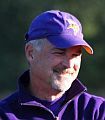ARTICLE: “What would you tell newly elected local government representatives about Sustainable Service Delivery through asset management? – A water sustainability perspective “(Winter 2023 issue of Asset Management BC Newsletter)

“My over-arching message to those elected in October 2022 is succinct: Get the water part right in a changing climate, and you will be amazed how other parts of the community resiliency puzzle then fall into place. A supporting message is this: Our land ethic has consequences for water. This means elected representatives need to understand why development practices disconnect the water balance pathways that power stream-ecology. They also need to understand why a water-first approach to green infrastructure can reconnect the two,” stated Kim Stephens.
DOWNLOAD A COPY OF: “Living Water Smart in British Columbia: Shelly Creek in Parksville is a “living laboratory” – released by the Partnership for Water Sustainability in April 2023

Peter Law has put his time and energy into Shelly Creek, as do many other stream stewards in their watersheds around BC, such that Shelly Creek has become a “living laboratory” for the local Parksville community to enjoy. “Enhanced riparian greenways like Shelly Creek Park allow fish to survive in natural conditions without encroachment issues. That 1990s decision to create an enhanced linear park showed great foresight. The proof of the pudding is that it saved the resident Cutthroat trout population during the heat dome and extreme drought of 2021,” stated Peter Law.
DOWNLOAD A COPY OF: “Living Water Smart in British Columbia: Fifty Years – and miraculously still here: BC’s Agricultural Land Reserve” – released by the Partnership for Water Sustainability in April 2023

Most British Columbians do not know a British Columbia without the ALR. “With only about 5% of BC’s land area capable of agricultural use, 50 years ago it was estimated we were losing 6000 hectares per year to non-farm uses. It was clear that local governments could not withstand development pressures upon this scarce provincial resource, In 1973, the Agricultural Land Reserve not only preserved the land for food production for present and future generations, but it preserved the option to plan our settled communities to be more resilient and sustainable,” stated Joan Sawicki.
DOWNLOAD A COPY OF: “Living Water Smart in British Columbia: Looking at green roofs through a water balance lens” – released by the Partnership for Water Sustainability in April 2023

Given how our climate is changing – with longer, drier summers being BC’s new reality – communities must adapt to a changing seasonal water balance. Harvy Takhar’s connected blue-green roof (BGR) may well prove to be an important piece in a long-term strategy for water balance management. “BGR systems are a novel nature-based solution for climate change adaptation and mitigation that provides multiple benefits to the urban environment,” stated Harvy Takhar. He has re-energized an aspect of green roof research that had lain dormant for two decades.
DOWNLOAD A COPY OF: “Living Water Smart in British Columbia: Local governments invest in youth at Vancouver Island University” – released by the Partnership for Water Sustainability in April 2023

“The story behind the story is about the importance of embedding knowledge of EAP into the youth who are going to be the future of our local governments. The framework that we have set up ensures this will happen. We have a commitment from the Partnership for Water Sustainability to provide oversight and mentoring during a 3-year transition period. And three local governments – Municipality of North Cowichan, City of Nanaimo, and the Regional District of Nanaimo – are committed to providing project work experience for students,” stated Graham Sakaki.
DOWNLOAD A COPY OF: “Living Water Smart in British Columbia: History and application of a science-based road map for either protecting or restoring stream system integrity” – released by the Partnership for Water Sustainability in March 2023

In the 1990s, Puget Sound research correlated land use changes with impacts on stream system condition. This was the springboard for BC to develop methodologies and metrics for science-based solutions. “It was when I decided to take advantage of a Fellowship Program to do my PhD that I hooked up with Rich Horner. This was at the start of the Puget Sound research project and proved to be good timing. We looked at why salmon stocks were declining in Puget Sound. We established that the loss of riparian and watershed land cover has a real impact before water quality does,” stated Chris May.
DOWNLOAD A COPY OF: “Living Water Smart in British Columbia: Communities need annual budgets to tackle the Riparian Deficit along streams” – released by the Partnership for Water Sustainability in March 2023

The requirement for an Asset Management Plan addresses the disconnect between land use oversight and direct responsibility for maintenance and management of stream corridor condition. “The oversight question is one that we are addressing with EAP, the Ecological Accounting Process. Local governments have real data to quantify the financial value of streams as physical assets. This metric allows them to put streams into the basket of local government asset management responsibilities,” stated Tim Pringle.
DOWNLOAD A COPY OF: “Living Water Smart in British Columbia: Build bridges of understanding, pass the baton!” – released by the Partnership for Water Sustainability in March 2023

“Over the past 30 years, a series of provincial government initiatives established a direction for water sustainability, including Stewardship of the Water of BC in 1993, the Fish Protection Act in 1997, and the Water Conservation Strategy for BC in 1998. The high-water mark is Living Water Smart, British Columbia’s Water Plan, released in 2008. The Water Sustainability Act is another key piece; the Partnership is committed to furthering its implementation and collaborating with the provincial government to fill gaps and improve the legislation.,” stated Kim Stephens.
A 3-YEAR STRATEGY FOR ENSURING CONTINUITY OF THE PARTNERSHIP NETWORK: “Growing and sustaining the network is very much about finding those to whom we can pass the baton. At the end of the day, however, ensuring continuity of the network is really about how organizations continue within the network,” stated Ted van der Gulik in his President’s Perspective (Annual Report 2022, Partnership for Water Sustainability in BC)

“A Partnership strength is the real-world experience we bring because of our multiple initiatives under Living Water Smart Actions. Under that vision, various building blocks processes have evolved over the decades. The Watershed Security Strategy and Fund, an initiative of the current provincial government, is the obvious mechanism to revisit, understand, learn from, and leverage past successes in the building blocks continuum. We have tools to help do the job. We can achieve better stewardship of BC’s water resources for present and future generations,” stated Ted van der Gulik.
DOWNLOAD A COPY OF: “Living Water Smart in British Columbia: Town of Comox – beacon of inspiration for water balance approach to land development” – released by the Partnership for Water Sustainability in March 2023

“The Drainage Infrastructure Protection and Runoff Control bylaws were a key shift. Jim Dumont had a key role in helping us think through the implementation details. Creating the bylaws definitely shows that the Town is serious. We have to follow our bylaws now. It’s the law!” stated Shelley Ashfield. The Town had to re-invent what have been accepted development practices. Historical failure by designers to apply the fundamentals of a water balance approach perpetuates degrading of urban streams.

